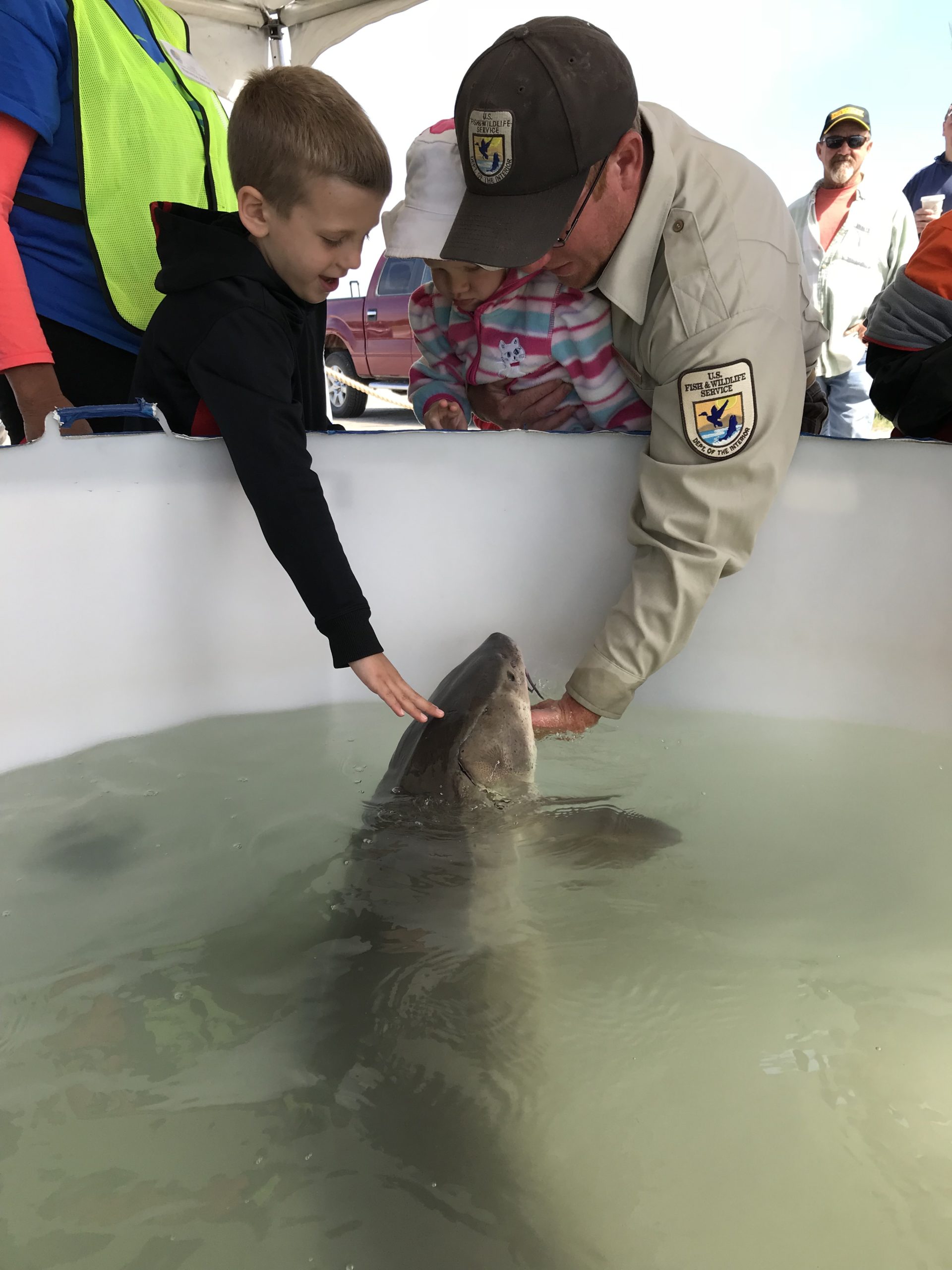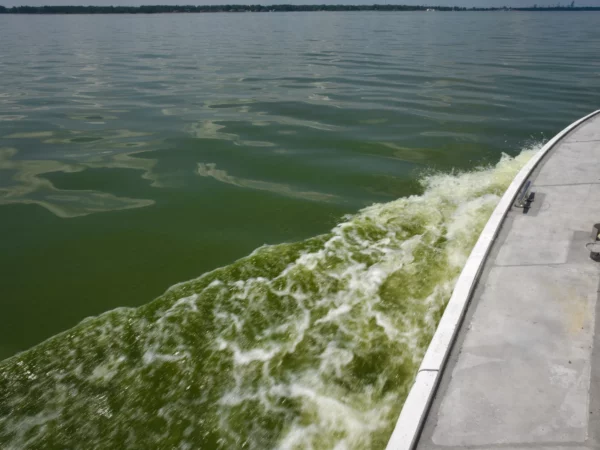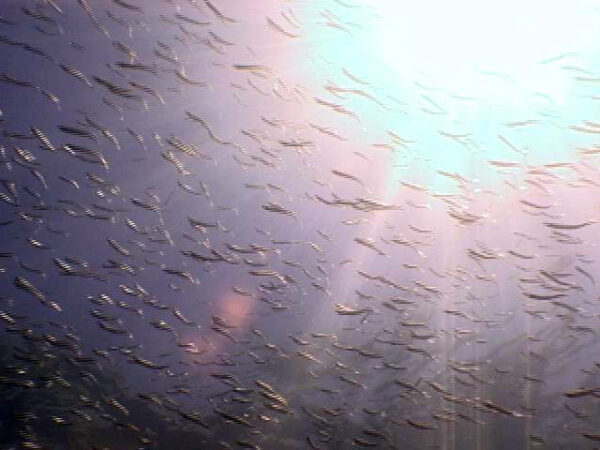
This story is the fourth in a four-part series looking at sturgeon restoration efforts.
Lake sturgeon restoration efforts are taking place across the Great Lakes basin.
But what that restoration looks like is entirely dependent on location and other factors, such as whether or not any lake sturgeon remain in the area.
In the few locations in the Great Lakes where lake sturgeon still spawn successfully, restoration efforts are focused on studying and managing those existing populations or boosting low populations. In the majority of the Great Lakes rivers and bays where the lake sturgeon populations have been lost, the restoration goal is to bring them back.
In Wisconsin and northern Michigan, two healthy populations of lake sturgeon spawn near the base of dams. These shallow-water spawning sites are an asset to researchers but also require volunteers to stand guard over the lake sturgeon to thwart poachers and manage eco-tourists.
On some rivers, streamside hatcheries are popping up. These seasonal facilities are focused on improving lake sturgeon survival rates and successful natal imprinting. Other areas are using traditional stocking methods to increase lake sturgeon numbers.
And one area is helping their lake sturgeon population by hosting an annual party.
Celebrating Sturgeon on the St. Clair River
There is only one river in the Great Lakes where no dams have been installed and the local conditions have allowed lake sturgeon to continue spawning in the same way they have for thousands of years.
The largest lake sturgeon spawning events in the Great Lakes take place each year in 60 feet of water in the Upper St. Clair River. This deep-water site prohibits poaching and also limits researcher and eco-tourism opportunities.
Until recently, there were no public sculptures on display or sturgeon-themed T-shirts being sold in shops around Port Huron, Michigan, or Sarnia, Ontario.
In 2012, a group of lake sturgeon advocates boarded the Huron Lady, a day cruise ship operating out of Port Huron. The group included local business owners, researcher biologists and board members from the non-profit groups Friends of the St. Clair River and Sturgeon for Tomorrow.
A failed bid by an energy developer to install a turbine field on the bottom of the St Clair River directly on top of the lake sturgeon spawning grounds had revealed a conservation issue. Only a handful of individuals were aware that upwards of 10,000 lake sturgeon spawned under the Blue Water Bridges each spring.
The St. Clair River sturgeon didn’t need to be restored, but the nearly successful energy development illuminated an urgent need for protection of the site.
The group of sturgeon advocates agreed that it was time to raise awareness, champion and celebrate the largest remaining free-range spawning population of lake sturgeon in the Great Lakes.
Their challenge was finding ways to build advocacy for a population of fish that no one could see. Not only was the Blue Water spawning site in deep water but it was also beneath one of the busiest commercial waterways in the Great Lakes. The inaccessibility of the site to all but a few skilled divers was one of the main reasons the site was generally unknown.
“I was amazed by how many people who have lived here their whole lives and are completely unaware that we have sturgeon here,” said Jenny Ciolek, owner of the Huron Lady cruise ship.
To save this site, the public needed to see the fish. Before the boat ride ended, a plan was hatched.
Large television screens would be installed on the Huron Lady, and guests would be taken out to the spawning site. A team of professional scuba divers would take a livestream camera down and film the spawning grounds for viewers above.
In addition to the tour boat, researchers from the U.S. Fish and Wildlife Service and the Michigan Department of Natural Resources agreed to setup tanks on shore with each stage of a lake sturgeon’s life cycle represented. One tank for newly spawned eggs and another for newly hatched eggs all the way through to adults which could be kept in the live-well on their research vessel.
The following year, in the spring of 2013, the Blue Water Sturgeon Festival was launched in Port Huron, Michigan.
“The festival isn’t just a date drawn out of a hat,” said Sheri Faust, president of the non-profit group Friends of the St. Clair River. “That’s when the sturgeon are migrating to the Upper St. Clair River, so the sturgeon dictate when the festival happens not us.”
When the first weekend in June arrived, thousands of lake sturgeon returned to the St. Clair River for their annual spawn. But for the first time in recent history, thousands of interested people also gathered at the river to celebrate the occasion.
Each year the festival expanded. An educational program for fifth-graders was added. Every class that participates receives a classroom presentation on sturgeon biology and ecology. They participate in a poster contest, and the program culminates at the end of the school year with a ride on the Huron Lady cruise ship.
“Altogether, we’ve given sturgeon cruises to 1,200 fifth-graders,” Faust said.
Faust said the goal of the festival is to get people excited about sturgeon. The festival offers a range of activities designed to engage all ages from in-depth educational workshops to tanks of hatching sturgeon eggs.
Researchers from the U.S. Fish and Wildlife Service and the Michigan Department of Natural Resources are on hand at the festival to talk about sturgeon biology and answer questions.
The researchers also created a pop-up touch-tank by circulating river water through a large plastic kiddie pool. Two adult sturgeon are caught in the river and placed in the pool for a few hours allowing festival goers the rare opportunity of actually touching an adult lake sturgeon.
Birthday cakes are purchased in commercial sheets and hundreds of pieces are handed out for free in celebration of all the sturgeon that hatch each year.
A sidewalk chalk artist from Holland, Michigan, became another event regular.
And a drum circle from the Walpole Island First Nation opened and closed each festival.
“I think the Sturgeon Fest does a lot for awareness,” Ciolek said.
Building public awareness is critical because saving this lake sturgeon spawning site begins with people caring, “and that in turn goes hand in hand with helping to preserve and protect,” Ciolek said.
The Blue Water Sturgeon Festival was thriving and growing right up to the spring of 2020 when public events were shut down by COVID-19. A modified version of the festival took place in 2021. Faust said they hope to offer a full version in 2022.
“We want to get people to understand the significance of sturgeon in the river and ultimately turn people into stewards,” Faust said.
Next spring, thousands of lake sturgeon will return to the Upper St. Clair River to spawn as they have for centuries, and event organizers are hopeful that festival goers will be able to return as well.
Catch more news at Great Lakes Now:
Sturgeon Restoration: Starting anew in Sturgeon and Saginaw bays
Sturgeon Restoration: Streamside hatcheries on the Manistee, Milwaukee and Maumee rivers
Sturgeon Restoration: Studying Michigan’s and Wisconsin’s current flourishing populations
Featured image: Blue Water Sturgeon Festival touch tank (Photo Credit: Greg Lashbrook/PolkaDot Perch)




